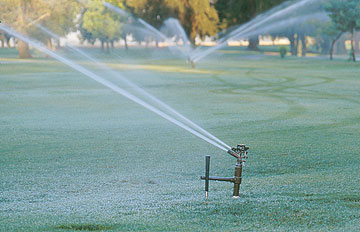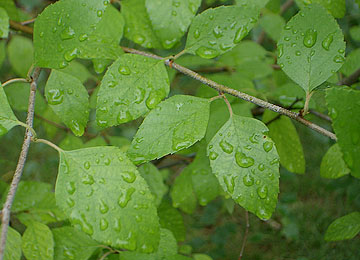- Home
- Learn about salinity
- Get to know your site
- Design a landscape
- Solve a problem
- Other information
Salinity Management Guide

Evaluating your irrigation water
Of all a landscape's managed inputs, irrigation water is the one that most influences the accumulation of salts in the landscape's soil. That's why it's important to analyze the water thoroughly.
Reviewing your field notes
Scan your field notes for any information that could help pinpoint a water-related problem that may also be salinity-related.
Also examine your notes to determine whether the plants within each irrigated area — each hydrozone — have not only a similar need for water but also similar tolerances to salinity. The salt tolerance of one species of plant can differ considerably from that of another. If you find that plants of widely different salt tolerance exist together in a single hydrozone, consider moving some of them, placing them with others that are more compatible.
Reviewing the laboratory report

When reviewing the laboratory's findings regarding your samples of irrigation water, focus on those chemical parameters that are most relevant for determining whether the water is inducing or may in the future induce a problem with salinity. Typically, they include the following:
- Electrical conductivity of the water (ECw): This is a convenient measure of a water's overall salinity.
- Total dissolved salts in the water (TDS): Another measure of a water's overall salinity.
- Sodium adsorption ratio of the water (SARw): This is the ratio of the water's concentration of sodium ion relative to its concentrations of calcium ion and magnesium ion.
The laboratory will measure the concentrations of sodium, calcium, and magnesium in the water and will then calculate the water's SAR for you.
If soil-dispersing sodium predominates, then the soil's permeability is probably relatively low. If soil-stabilizing calcium and magnesium predominate, then the soil's permeability will likely be moderate or relatively high, all other things being equal.
- Concentrations of sodium, chloride, and boron in the water: At high levels, these can injure many species of plants, especially when sprinkled onto foliage. Some species are much more sensitive to sodium, chloride, and boron than are others.
Depending on the concentrations in the irrigation water, and depending on the soil's permeability, some of the sodium, chloride, or boron in the water may remain near the surface of the soil, where relatively high concentrations of them may injure the roots and shoots of sensitive plants.
To use your water quality results to assess whether it's likely your landscape has (or will eventually have) a salinity-related problem, consult the table titled Interpreting the results from salinity-related tests of irrigation water. The table provides information regarding the acceptable ranges of EC, sodium, chloride, and boron. It also indicates the average composition of certain recycled waters used in southern California.
| « Previous page | Next page » |